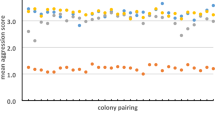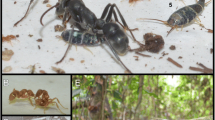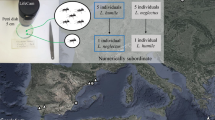Abstract
The Argentine ant (Linepithema humile) is an invasive species that disrupts the balance of natural ecosystems by displacing indigenous ant species throughout its introduced range. The mechanisms by which Argentine ants effectively compete against native ant species have been previously addressed in field studies that centered on interference and exploitation competition at baits and mainly examined the colony-level performance of Argentine ants. Detailed behavioral observations explaining the basis for the strong competitive ability of L. humile are comparatively rare. To gain a better understanding of the mechanisms by which Argentine ants displace native ants we examined the aggressive interactions between the Argentine ants and the odorous house ant, Tapinoma sessile in four different aggression assays: (1) worker dyad interactions, (2) symmetrical group interactions, (3) intruder introductions into an established resident colony, and (4) a resource competition assay which focused on competition for food and nesting space. Our results demonstrate a clear disparity between worker-level and colony-level fighting ability of Argentine ants and provide behavioral evidence to explain the superior interference ability of Argentine ants in group assays. Argentine ants experienced mixed success in fighting against odorous house ants in dyad interactions, but gradually gained a numerical advantage in symmetrical group interactions by active cooperation among nestmates. Results of the resource competition assay indicate that Argentine ants recruit rapidly, numerically dominate food and nesting sites, and aggressively displace T. sessile from baits. Taken together, the results of these assays allow us to pinpoint the behavioral mechanisms responsible for the remarkable competitive ability of Argentine ants.


Similar content being viewed by others
References
Adams ES (1990) Boundary disputes in the territorial ant, Azteca trigona: effects of asymmetries in colony size. Anim Behav 39:321–328
Alder P, Silverman J (2005) Effects of interspecific competition between two urban ant species, Linepithema humile and Monomorium minimum, on toxic bait performance. J Econ Entomol 98:493–501
Buczkowski G, Vargo E, Silverman J (2004) The diminutive supercolony: the Argentine ants of the southeastern United States. Mol Ecol 13:2235–2242
Buczkowski G, Silverman J (2005) Context-dependent nestmate discrimination and the effect of action thresholds on exogenous cue recognition in the Argentine ant. Anim Behav 69:741–749
Buczkowski G, Bennett GW (2006) Dispersed central-place foraging in the polydomous odorous house ant, Tapinoma sessile as revealed by a protein marker. Ins Soc 53:282–290
Bhatkar AD, Whitcomb WH (1970) Artificial diet for rearing various species of ants. Fl Entomol 53:229–232
Creighton WS (1950) The ants of North America. Bulletin of the Museum of Comparative Zoology, vol 104, 585 pp
Fellers JH (1987) Interference and exploitation in a guild of woodland ants. Ecology 69:1466–1478
Gary NE (1975) Activities and behavior of honey bees. In: The hive and the honey bee. Dadant and Sons, Hamilton, IL
Giraud T, Pedersen JS, Keller L (2002) Evolution of supercolonies: the Argentine ants of southern Europe. Proc Natl Acad Sci USA 99:6075–6079
Gordon DM (1989) Ants distinguish neighbors from strangers. Oecologia 81:198–200
Hölldobler B, Lumsden CJ (1980) Territorial strategies in ants. Science 210:732–739
Hölldobler B, Wilson EO (1990) The ants. The Belknap Press of Harvard University Press, Cambridge, MA
Holway DA (1995) Distribution of the Argentine ant (Linepithema humile) in northern California. Conserv Biol 9:1634–1637
Holway DA (1998) Effect of Argentine ant invasions on ground-dwelling arthropods in northern California riparian woodlands. Oecologia 116:252–258
Holway DA (1999) Competitive mechanisms underlying the displacement of native ants by the invasive Argentine ant. Ecology 80:238–251
Holway DA, Case TJ (2000) Mechanisms of dispersed central-place foraging in polydomous colonies of the Argentine ant. Anim Behav 59:433–441
Holway DA, Lach L, Suarez AV, Tsutsui ND, Case TJ (2002) Causes and consequences of ant invasions. Annu Rev Ecol Evol Syst 33:181–233
Holway DA, Suarez AV (2004) Colony-structure variation and interspecific competitive ability in the invasive Argentine ant. Oecologia 138:216–222
Human KG, Gordon DM (1996) Exploitation and interference competition between the invasive Argentine ant, Linepithema humile, and native ant species. Oecologia 105:405–412
Human KG, Gordon DM (1999) Behavioral interactions of the invasive Argentine ant with native ant species. Ins Soc 46:159–163
Jaffe K, Bazire-Benazet M, Howse PE (1979) An integumentary pheromone-secreting gland in Atta sp.: territorial marking with a colony-specific pheromone in Atta cephalotes. J Insect Physiol 25:833–839
Lanchster FW (1916) Aircraft in warfare. Appleton, New York, NY
Markin GP (1970) The seasonal life cycle of the Argentine ant, Iridomyrmex humilis (Hymenoptera: Formicidae) in southern California. Ann Entomol Soc Am 63:1238–1242
Mayade S, Cammaerts MC, Suzzoni JP (1993) Home range marking and territorial marking in Cataglyphis cursor (Hymenoptera: Formicidae). Behav Proc 30:131–142
Nowbahari E, Fénéron R, Malberbe M (1999) Effect of body size on aggression in the ant, Cataglyphis niger (Hymenoptera: Formicidae). Aggress Behav 25:369–379
Passera L (1994) Characteristics of tramp species. In: Williams DF (ed) Exotic ants: impact and control of introduced species. Westview Press, Boulder, CO
Roulston TH, Buczkowski G, Silverman J (2003) Nestmate discrimination in ants: effect of bioassay on aggressive behavior. Ins Soc 50:151–159
Roura-Pascual N, Suarez AV, Gomez C, Pons P, Touyama Y, Wild AL, Peterson AT (2004) Geographical potential of Argentine ants (Linepithema humile Mayr) in the face of global climate change. Proc R Soc Lond B 271:2527–2534
Rowles AD, O’Dowd DJ (2007) Interference competition by Argentine ants displaces native ants: implications for biotic resistance to invasion. Biol Invasions 9:73–85
Sands WA (1982) Agonistic behavior of African soldierless Apicotermitinae (Isoptera: Termitidae). Sociobiology 7:61–73
SAS Institute (2002) SAS/STAT guide for personal computers, Version 8.1. SAS Institute, Cary, NC
Sakata H, Katayama N (2001) Ant defence system: a mechanism organizing individual responses into efficient collective behavior. Ecol Res 16:395–403
Shattuck SO (1992) Generic revision of the ant subfamily Dolichoderinae (Hymenopetra: Formicidae). Sociobiology 21:1–181
Starks PT, Fischer DJ, Watson RE, Melikian GL, Nath GL (1998) Context-dependent nestmate discrimination in the paper wasp, Polistes dominulus: a critical test of the optimal acceptance threshold model. Anim Behav 56:449–458
Suarez AV, Tsutsui ND, Holway DA, Case TJ (1999) Behavioral and genetic differentiation between native and introduced populations of the Argentine ant. Biol Inv 1:43–53
Suarez AV, Holway DA, Case TJ (2001) Patterns of spread in biological invasions dominated by long-distance jump dispersal: insights from Argentine ants. Proc Natl Acad Sci USA 98:1095–1100
Suarez AV, Holway DA, Liang D, Tsutsui ND, Case TJ (2002) Spatiotemporal patterns of intraspecific aggression in the invasive Argentine ant. Anim Behav 64:697–708
Tanner CJ (2006) Numerical assessment affects aggression and competitive ability: a team-fighting strategy for the ant Formica xarophila. Proc R Soc Lond B 273:2737–2742
Thomas ML, Holway DA (2005) Condition-specific competition between invasive Argentine ants and Australian Iridomyrmex. J Anim Ecol 74:532–542
Thompson RC (1990) Ants that have pest status in the United States. In: Vander Meer RK, Jaffe K, Cedeno A (eds) Applied myrmecology: a world perspective. Westview Press, Oxford
Touyama Y, Ogata K, Sugiyama T (2003) The Argentine ant, Linepithema humile, in Japan: assessment of impact on species diversity of ant communities in urban environments. Entomol Sci 6:67–62
Traniello JFA, Beshers SN (1991) Maximization of foraging efficiency and resource defense by group retrieval in the ant Formica schaufussi. Behav Ecol 29:283–289
Tsutsui ND, Suarez AV, Holway DA, Case TJ (2000) Reduced genetic variation and the success of an invasive species. Proc Natl Acad Sci USA 97:5948–5953
Wilson EO (1971) The insect societies. The Belknap Press, Cambridge, MA
Zar JH (1999) Biostatistical analysis. Prentice Hall, NJ
Zee J, Holway DA (2006) Nest raiding by the invasive Argentine ant on colonies of the harvester ant, Pogonomyrmex subnitidus. Ins Soc 53:161–167
Acknowledgments
We thank Jeffrey Holland and two anonymous reviewers for helpful comments on the manuscript, C. Cummins for technical assistance, G. Fedorowicz for Argentine ants from California, J. Silverman for Argentine ants from North Carolina, and T. Clough for statistical advice. This study was supported in part by the Norm Ehmann Endowment Fund Award and the Industrial Affiliates Program at Purdue University.
Author information
Authors and Affiliations
Corresponding author
Rights and permissions
About this article
Cite this article
Buczkowski, G., Bennett, G.W. Aggressive interactions between the introduced Argentine ant, Linepithema humile and the native odorous house ant, Tapinoma sessile . Biol Invasions 10, 1001–1011 (2008). https://doi.org/10.1007/s10530-007-9179-9
Received:
Accepted:
Published:
Issue Date:
DOI: https://doi.org/10.1007/s10530-007-9179-9




